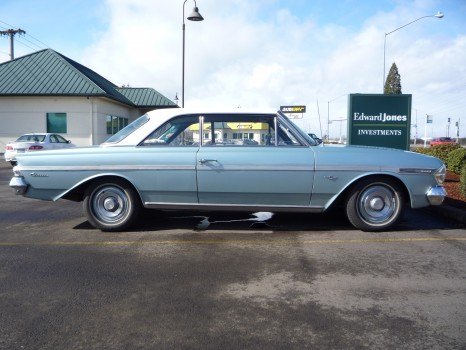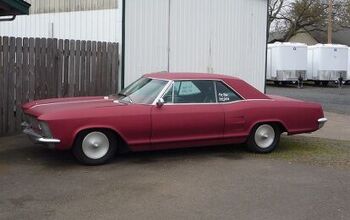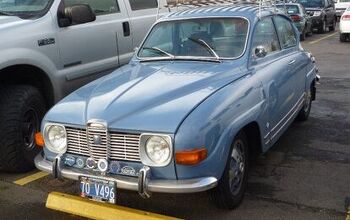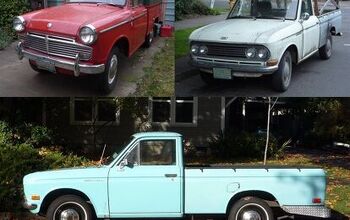Curbside Classics: 1964 Rambler Classic

What makes a car a true classic? Being one of the handsomest and most enduring designs of its time? Staying in production for twenty years? Having a long-stroke in-line engine with a classic OHC hemi-head? Winning a big race at the ’Ring? Having illustrious heads of state as loyal owners? Or just slapping a chrome “Classic” badge on its flanks? How does this Rambler stack up? Has it earned its chops, or is it an impostor?
In 1963, a professor in Iowa City bought a Classic hardtop like this for his wife. As I walked by it every day on my trudge to school, I gave the Rambler a whole lot more eyeball time than average. Being an OCD car gazer, that’s saying something.
This Classic challenged all my constructs about Ramblers: they just weren’t cool, period. Popular enough with the thrifty folks in the Midwest, their styling was atrocious. The 1961-1963 Rambler American takes the cake as one of the all-time stinkers. And I’ll never forget the shock of going to the dealer and lifting a hood on a ’63 American: it still had a flathead six, with only 90 hp! It was the last flathead engine still being made.
But that all began to change in 1963, after Dick Teague became chief stylist. Teague faced a momentous challenge: how to replace both the compact American and the mid/full size Classic and Ambassador with AMC’s limited budget. The answer was a brilliant two-in-one deal. The dramatically clean and handsome Classic/Ambassador sedans and wagons arrived in 1963, (rightfully) winning Motor Trend’s COTY. Teague cleaned it up even more for ’64, and added this particularly attractive hardtop coupe, Rambler’s first ever. Compared to the bloated and often fussy competition with their huge front and rear overhangs, this Classic was almost European in size, trimness, and cleanness of line.
Teague’s Act II was the compact ’64 American. By simply narrowing and shortening the unibody Classic platform, the American recycled the same doors, roof line, and many other body parts, not to mention the drive train and suspension. Rambler pioneered then what Audi “(re)invented” for its current range: a single set of platform components to cover their compact (A4), midsize (A6), and full-size (A8).
The only thing that spoiled these cars was the engines. The six was an OHV conversion of the old Nash flathead, and the 287 cubic inch V8 a small-bore version of the already obsolete AMC 327. The V8s were too heavy, casting a sentence of terminal understeer to the handling. But even with its Flash-O-Matic slushbox, this V8 Classic was reasonably lively in its day.
In production for twenty years? Not here in ADD-afflicted America, no thank you. When the Classic was restyled for again 1966, the blueprints and dies were bought by Kaiser’s Argentinean operation, IKA. The middle section of the Classic was mated with the front and rear of the American to create the Torino. In production until 1982, it became quite the legend.
Pop a Ritalin, because this story gets complicated. Renault bought IKA in 1975. So Renault was actually building AMC-designed cars in Argentina five years before they bought AMC. Maybe they were impressed by the Torino?
When Kaiser bought the Classic from AMC, it came sans engine. So Kaiser rummaged through its US warehouse and found just the thing for the Torino: the Kaiser Tornado straight six.
Back when Kaiser still owned Jeep (before selling it to AMC in 1970), it needed something fresher than its ancient old Continental-designed flathead six for the all-new 1963 Wagoneer. On a tiny budget, Kaiser’s Italian chief engineer designed a classic European-style OHC hemi-head. But under that new alloy head sat the old flathead block. But who knew?
America’s first main-stream OHC engine, the Tornado something of a (brief) sensation, until it started leaking and burning oil, overheating, and warping its beautiful aluminum cylinder heads. So in 1966, the Tornado was given a one-way ticket to Argentina, and Kaiser/Jeep started buying engines from . . . AMC!
But the Argentineans welcomed the Tornado with open arms, and began a steady development program that ended up with the 380W. Sporting three horizontally-mounted Webers, it cranked out over 300 hp (220 net). The Torino was the GTO/Hemi ’Cuda of Argentina. And so it went racing.
In 1969 three Torinos were sent to the 84 hour endurance race at Nurburgring. Amazingly, they won their class, and were a threat to the overall winner. Not bad, for an engine running a huge 4.38″ stroke in its antediluvian cylinder block.
The Latinized Classic earned quite a rep from its racing successes and developed a cult following. Among devoted Torino buyers were such global luminaries as Fidel Castro, Leonid Brezhnev and Muammar Gaddafi. You know these guys wouldn’t have anything less than a genuine classic in their collections.

More by Paul Niedermeyer
Latest Car Reviews
Read moreLatest Product Reviews
Read moreRecent Comments
- El scotto Dale Carnegie had his grandkids do some upgrades?
- El scotto Work it backwards. How many people use Tesla Super Chargers: Primary Charging Point - this is my normal charging station; Secondary charging station - at a retail location or planned on trips, Rarely or Not at All.
- FreedMike Some clarification would make sense here: Tesla is laying off the team responsible for BUILDING NEW Supercharger stations. Apparently the ones already being built are going to be completed. The folks who maintain the current network are apparently unaffected. https://www.nytimes.com/2024/04/30/business/tesla-layoffs-supercharger-team.htmlAlso, many other other manufacturers are switching to NACS in the upcoming years, and some of those companies are already providing Supercharger adaptors for their non-NACS vehicles. Some Superchargers can already accomodate non-Tesla vehicles with a built in adaptor called the "magic dock."Given all this, my guess? They're trying to maximize utilization of the current system before building it out further.
- Dartman Damn Healey! You can only milk a cow so many times a day! Don’t worry though I bet Flex, 28, 1991, and all the usual suspects are just getting their fingers warmed up!
- FreedMike Your Ford AI instructor:






































Comments
Join the conversation
Thank you, amcramblermarlin, for trying to enlighten those who have spoken unkindly of the Rambler/AMC engines. I've driven the 327 and the 401. A LOT. I prefer the 327 with an automatic. I still have one. Back in the day, all one had to do was keep your foot on the brake, drop into second, wind that baby up, take your foot off the gas and blast off...leaving some poor soul in a Mopar/Ford/Chevy to ponder how he just got beat off the line by a GIRL driving her mother's pink Rambler wagon.
AMC has never gotten the credit it deserved. Their cars from the mid to late 60s were actually quite beautiful. I'd die for a Rogue convertible myself.